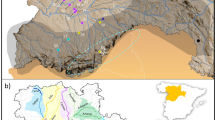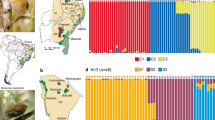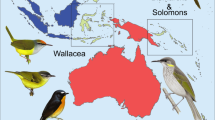Abstract
Increasing documentation of changes in the distribution of species provides evidence of climate change impacts1, yet surprisingly little empirical work has endeavoured to quantify how such recent and rapid changes impact genetic diversity2. Here we compare modern and historical specimens spanning a century to quantify the population genetic effects of a climate-driven elevational range contraction in the alpine chipmunk, Tamias alpinus, in Yosemite National Park, USA. Previous work showed that T. alpinus responded to warming in the park by retracting its lower elevational limit upslope by more than 500 m, whereas the closely related chipmunk T. speciosus remained stable3,4. Consistent with a reduced and more fragmented range, we found a decline in overall genetic diversity and increased genetic subdivision in T. alpinus. In contrast, there were no significant genetic changes in T. speciosus over the same time period. This study demonstrates genetic erosion accompanying a climate-induced range reduction and points to decreasing size and increasing fragmentation of montane populations as a result of global warming.
This is a preview of subscription content, access via your institution
Access options
Subscribe to this journal
Receive 12 print issues and online access
$209.00 per year
only $17.42 per issue
Buy this article
- Purchase on Springer Link
- Instant access to full article PDF
Prices may be subject to local taxes which are calculated during checkout


Similar content being viewed by others
References
Parmesan, C. Ecological and evolutionary responses to recent climate change. Annu. Rev. Ecol. Evol. Syst. 37, 637–669 (2006).
Bálint, M. et al. Cryptic biodiversity loss linked to global climate change. Nature Clim. Change 1, 313–318 (2011).
Moritz, C. et al. Impact of a century of climate change on small mammal communities in Yosemite National Park, USA. Science 322, 261–264 (2008).
Rubidge, E. M., Monahan, W. B., Parra, J. L., Cameron, S. E. & Brashares, J. S. The role of climate, habitat, and species co-occurrence as drivers of change in small mammal distributions over the past century. Glob. Change Biol. 17, 696–708 (2011).
Root, T. L. et al. Fingerprints of global warming on wild animals and plants. Nature 421, 57–60 (2003).
Schipper, J. et al. The status of the world’s land and marine mammals: Diversity, threat, and knowledge. Science 322, 225–230 (2008).
Blois, J. J. & Hadly, E. A. Mammalias response to Cenozoic climate change. Annu. Rev. Earth Planet. Sci. 37, 181–208 (2009).
Blois, J. L., Mcguire, J. L. & Hadly, E. A. Small mammal diversity loss in response to late-Pleistocene climatic change. Nature 465, 771–775 (2010).
Ozgul, A. et al. Coupled dynamics of body mass and population growth in response to environmental change. Nature 466, 482–485 (2010).
Réale, D., McAdam, A. G., Boutin, S. & Berteaux, D. Genetic and plastic responses of a northern mammal to climate change. Proc. R. Soc. Lond. B 270, 591–596 (2003).
Hewitt, G. M. Genetic consequences of climatic oscillations in the Quaternery. Phil. Trans. R. Soc. Lond. B 359, 183–195 (2004).
Soulé, M. E. in Conservation Biology: An Evolutionary-Ecological Perspective (eds Soulé, M. E. & Wilcox, B. A.) 151–169 (Sinauer, 1980).
Epps, C. W., Palsboll, P. J., Wehausen, J. D., Roderick, G. K. & McCullough, D. R. Elevation and connectivity define genetic refugia for mountain sheep as climate warms. Mol. Ecol. 15, 4295–4302 (2006).
Ditto, A. & Frey, J. Effects of ecogeographic variables on genetic variation in montane mammals: Implications for conservation in a global warming scenario. J. Biogeogr. 34, 1136–1149 (2007).
Hoffmann, A. A. & Sgro, C. M. Climate change and evolutionary adaptation. Nature 470, 479–485 (2011).
Spielman, D., Brook, B. W. & Frankham, R. Most species are not driven to extinction before genetic factors impact them. Proc. Natl Acad. Sci. USA 101, 15261–15264 (2004).
Cayan, D. R., Maurer, E. P., Dettinger, M. D., Tyree, M. & Hayhoe, K. Climate change scenarios for the California region. Climatic Change 87, S21–S42 (2008).
Sih, A., Jonsson, B. G. & Luikart, G. Habitat loss: ecological, evolutionary and genetic consequences. Trends Ecol. Evol. 15, 132–134 (2000).
McCallum, H. & Dobson, A. Disease, habitat fragmentation and conservation. Proc. R. Soc. Lond. B 269, 2041–2049 (2002).
Hoffmann, A. A. & Willi, Y. Detecting genetic responses to environmental change. Nature Rev. Genet. 19, 421–432 (2008).
Gienapp, P., Teplitsky, C., Alho, J. S., Mills, J. A. & Merila, J. Climate change and evolution: Disentangling environmental and genetic responses. Mol. Ecol. 17, 167–178 (2008).
Mullen, L. M., Hoekstra, H. E. & Feder, J. Natural selection along an environmental gradient: A classic cline in mouse pigmentation. Evolution 62, 1555–1570 (2009).
Raymond, M. & Rousset, F. GENEPOP (version 1.2): Population genetics software for exact tests and ecumenicism. J. Heredity 86, 248–249 (1995).
Chapuis, M. P. & Estoup, A. Microsatellite null alleles and estimation of population differentiation. Mol. Biol. Evol. 24, 621–631 (2007).
Nei, M. & Kumar, S. Molecular Evolution and Phylogenetics (Oxford Univ. Press, 2000).
Kalinowski, S.T. HP-RARE 1.0: A computer program for performing rarefaction on measures of allelic richness. Mol. Ecol. Notes 5, 187–189 (2005).
Weir, B. S. & Cockerham, C. C. Estimating F-statistics for the analysis of population structure. Evolution 38, 1358–1370 (1984).
Pritchard, J. K., Stephens, M. & Donnelly, P. Inference of population structure using multilocus genotype data. Genetics 155, 945–959 (2000).
Evanno, G., Regnaut, S. & Goudet, J. Detecting the number of clusters of individuals using the software STRUCTURE: A simulation study. Mol. Ecol. 14, 2611–2620 (2005).
Jensen, J. L., Bohonak, A. J. & Kelley, S. T. Isolation by Distance Web Service BMC Genetics 6: 13. v.3.16 http://ibdws.sdsu.edu/ (2005).
Acknowledgements
We are grateful to C. Conroy, the YNP resurvey field team, C. Patton and L. Chow for their role in collecting the modern field data and P. Elsen for his assistance in the lab. E.M.R. was supported by a National Science & Engineering Research Council PGS-D award, the Museum of Vertebrate Zoology and the Environmental Science, Policy and Management Department at the University of California, Berkeley, during this research. The project was financially supported by the Museum of Vertebrate Zoology at the University of California, Berkeley, the Yosemite Fund, the National Geographic Society and the National Science Foundation.
Author information
Authors and Affiliations
Contributions
E.M.R., J.L.P. and C.M. designed the study; E.M.R., J.L.P. and M.L. collected data; E.M.R. analysed and interpreted data; E.M.R., C.M., A.C.B. and J.S.B. wrote the paper. All authors discussed the results and commented on the manuscript.
Corresponding author
Ethics declarations
Competing interests
The authors declare no competing financial interests.
Supplementary information
Rights and permissions
About this article
Cite this article
Rubidge, E., Patton, J., Lim, M. et al. Climate-induced range contraction drives genetic erosion in an alpine mammal. Nature Clim Change 2, 285–288 (2012). https://doi.org/10.1038/nclimate1415
Received:
Accepted:
Published:
Issue Date:
DOI: https://doi.org/10.1038/nclimate1415
This article is cited by
-
Transcriptome wide analyses reveal intraspecific diversity in thermal stress responses of a dominant habitat‐forming species
Scientific Reports (2023)
-
Isolated on sky islands: genetic diversity and population structure of an endangered mountain lizard
Conservation Genetics (2023)
-
Suitable climate space and genetic diversity of the mountain-affiliated moth Cosmosoma maishei (Erebidae: Arctiinae: Arctiini: Euchromiina) in cloud forests of Chiapas, Mexico
Journal of Insect Conservation (2023)
-
Searching for genetic evidence of demographic decline in an arctic seabird: beware of overlapping generations
Heredity (2022)
-
High-elevational occurrence of two tick species, Ixodes ricinus and I. trianguliceps, at their northern distribution range
Parasites & Vectors (2021)



